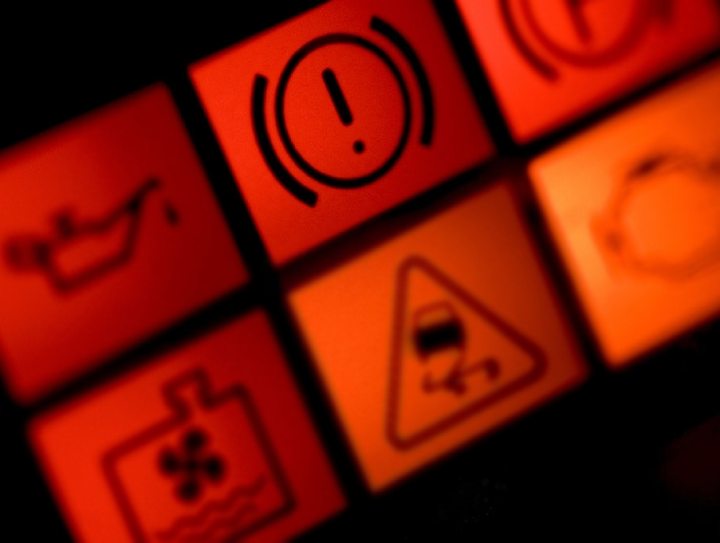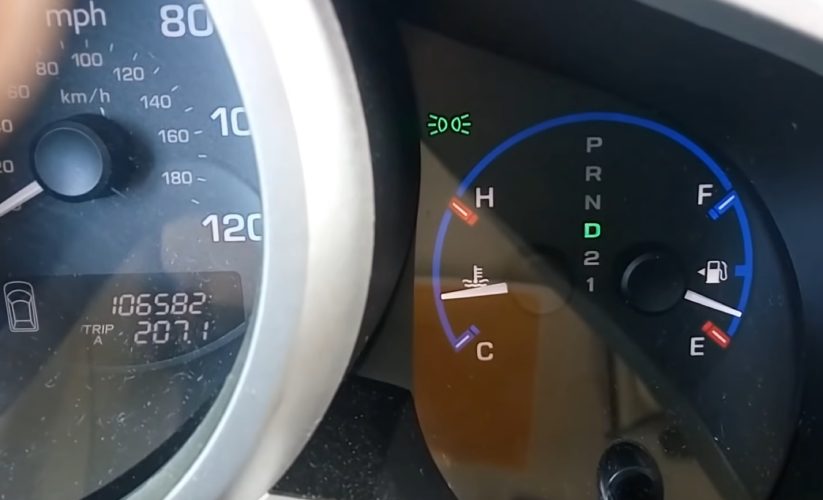The “Triangle of Death,” the name sends chills down the spine and conjures a picture of something so dreaded it should be avoided at all costs. Yes, you should do your best to avoid seeing the triangle of death. But it honestly isn’t as bad as you think.
If you are here because you saw a red triangle with an exclamation mark in the center on your car’s dashboard, then congratulations, you just saw the triangle of death and survived. Do you see? It is not so bad at all, the real problem comes if you fail to do something about it. So what does the red triangle with an exclamation mark mean on a Prius?
It signals that all is not well with your vehicle’s engine and that your attention is needed. This symbol though a thrive overdramatic for all the right reasons, is Prius’s version of the check engine light. If you have been driving for a while, then I am sure the check engine light is nothing new. But for some reason, Toyota decided to take the phrase “you can’t be too careful” to a whole new level with the Prius, and guess what? It worked. Chances are you would be more worried seeing the red triangle on your dashboard than the usual check engine light.
So what do you do if you see the red triangle of death? Stick around as I dig deeper into the red triangle’s causes, solutions, and symptoms.
Related Prius Troubleshooting Guide: Causes of the Prius P lock Malfunction
What Are the Causes of the Red Triangle?
There are a few things that would cause the red triangle to pop up on the dashboard. These are the battery, electrical grounding issues, and low oil pressure. Let’s begin with the most common cause:

The Battery
The major cause of the red triangle is the battery. Feedback from most drivers has ascertained this. That 9 out of 10 times, the On Board Diagnostic (OBD) will likely come up with error codes P0A80 and P3000. The Toyota Prius is a hybrid vehicle with both a gasoline engine and an electric motor. Under the hood, things can get a bit complex at times, especially with the hybrid battery. Monitoring the hybrid battery is the engine control unit (ECU). Most modern vehicles have an ECU that monitors the performance of the various components that are installed in the vehicle.
The HV ECU is a part of the vehicle’s Power Control Module (PCM). The PCM takes data from the systems it monitors and processes it to determine if all the components or systems in the vehicle are functioning as they should. The HV battery ECU has the specific job of monitoring the performance of the HV battery. If things don’t add up, the ECU reads this as a problem and either displays an error message or triggers some form of alert system to warn the driver. The HV battery ECU is responsible for such things as controlling the boost converter, which boosts the output voltage of the HV battery and calculates the state of charge (SOC) by monitoring the voltage, current, and temperature.
All of these are done to ensure that the battery pack charges and discharges properly. If anything was to go wrong with the ECU, you could see how this would be detrimental to the vehicle. That is where the Code P300 comes in. This code signifies a problem with the ECU controlling the HV battery. You should look out for some symptoms, and I will talk about that later.
The P0A80 code is similar to the P300 error code. But while the latter identifies a problem with the HV battery’s ECU, the former identifies a problem with the battery itself. That is to say, the P0A80 error code is a sign of a failing battery. Precisely, it means that one or more cells in the HV battery are either dead or dying. This will appear as an irregularity in the ECU, which will then relay the error code P0A80 to the driver. This code is often interpreted as “Replace Hybrid Battery Pack.”
Although I mentioned that the P0A80 code is likely caused by a failed battery cell, there are other reasons as well. Such as high cell resistance, irregular cell voltage or temperature, defective HV battery pack, and disconnected busbar cables or connectors, all of which will affect the performance of the HV battery pack.
How Do You Fix a Faulty Battery?
There’s not a lot you can do here. You will have to replace or recondition the Hybrid battery pack. Rebuilding the battery will cost between $1000 and $2000 depending on how many cells need replacing, while replacing the entire battery pack can run up to $3500.
Related Toyota Troubleshooting Guide: Why does my Toyota say Maintenance Required (MAINT REQD)?
Weak 12V Battery
The Toyota Prius comes with two batteries, the bigger HV battery pack and the standard 12 battery. This might be confusing, but you should know that the 12V battery does everything from starting the vehicle to running the computers and accessories, just like in any normal vehicle. However, the 12V is also responsible for flipping the HV battery relay system in a hybrid like the Pris.
From then on, the HV battery pack comes to life, taking over most of the activities from the smaller 12v battery. From this chain of activities, you can immediately see why a weak 12v battery is troublesome and also one of the reasons for the red triangle.
How Do You Fix a Weak 12V Battery?
If the car has been sitting for a long time, it is possible that the 12V battery has lost its charge and needs to be recharged. This is easy to fix and won’t cost anything. If the 12V battery needs replacing, this will cost around $200, and most places will replace it for free.
Related Toyota Troubleshooting Guide: What Is the ICS Malfunction On Toyota?
Low Oil Pressure
As I said, 9 out of 10 times, the cause of the red triangle of death will likely be an issue with the battery or the battery’s control unit. But the battery is not always to be blamed for this. Sometimes, the red triangle could be caused by low oil pressure. Remember, the Prius is a hybrid vehicle, so it still needs oil to keep the engine running smoothly. Unlike with regular cars, there is a tendency to lose track of your oil change times when you drive a hybrid.
But the hybrid is not a full-blown electric vehicle, and so when the oil is not sufficient or dirty, the vehicle’s performance is impaired. Low oil pressure can result from leakage in the engine, dirty oil, or oil burn. Literally, anything that causes the engine’s oil level to drop below the acceptable limit. This can cause the engine to stall or even shut off completely. To prevent this, the system warns the driver with the red triangle when the oil pressure gets dangerously low.
How Do You Fix a Low Oil Pressure?
In this case, a simple oil change or top-up will suffice. But what happens when the oil pressure is normal? So, how do you fix the red triangle of death? Before I talk about that, here are some symptoms you should look out for.
Common Symptoms of a Red Triangle
Before seeing the red triangle, there are some symptoms you may notice if you pay close attention to your vehicle. Some of these symptoms are visual and easy to detect, while others are not. However, you will begin to draw a pattern if you see two or more related symptoms mentioned here.
P0A80 and P300 Error Codes
Of course, the very first symptom you will likely encounter is the P0A80 and P300 error codes. I have talked about each error code in detail. If you see any of these codes, it is a sure sign that something is wrong in the battery compartment that needs to be taken care of ASAP. Further diagnosis to pinpoint the exact causes can be done using the OBD tool.
Fuel Gauge Fluctuations and Incorrect Reading
The next visual sign you would notice is that the fuel gauge keeps fluctuating or gives an inaccurate reading. The fuel gauge sender is one of the many components that depend on the battery. So if there is a problem with the battery, you may notice inconsistent readings from the fuel gauge.
The Blower Fan Regularly Kicks On
Inside the HV battery pack is a small temperature-regulating device known as the blower fan. The blower fan is controlled by the battery ECU, which monitors the battery’s operating temperature. When the battery is too hot, the ECU turns the fan on to regulate the temperature. If this happens a lot, it means your battery is getting too hot, and this will reduce its capacity. If the situation is not remedied, you will eventually get the red triangle.
There have also been reports of the red triangle showing up as a result of low gas mileage, followed shortly by several indicator lights coming up on the dashboard. If you see these symptoms, then sooner or later, you will be greeted by the dreaded red triangle of death.
Related Toyota Troubleshooting Guide: What Does the Check Hybrid System Warning Mean?
Should You Drive Your Prius If It Displays a Red Triangle?
No. Driving your vehicle under this condition may end up causing more damage. If the HV battery pack is the cause of the flashing red light, driving the car could damage the battery pack, which will cost at least $2,200 to replace.
In addition, you may end up damaging other sensitive electronic components in your vehicle, or even worse, your vehicle may cease to function in the middle of the road. The best thing to do is to park your vehicle, turn it off and check to see if there is any recognizable cause of the red triangle. Otherwise, you have to drive to the mechanic as quickly as possible.
Conclusion
Whether you call it the check engine light or the red triangle of death, this is our vehicle’s way of telling us it’s time for a check-up. Under no circumstance should you ignore these warning signs, or else you will be putting your vehicle and your life at risk. So that’s all about the red triangle of death.
Iliah is the co-founder of Mechanic Ask, where he writes detailed step-by-step tutorials for repairs and mods. He also posts videos walking through things like engine swaps, suspension lifts, and tuning chips. Iliah uses his blog as an educational resource for car enthusiasts based on the knowledge he’s gained from 15 years as an ASE-certified master technician. His repair manuals provide even novice readers the confidence to take on big projects.









